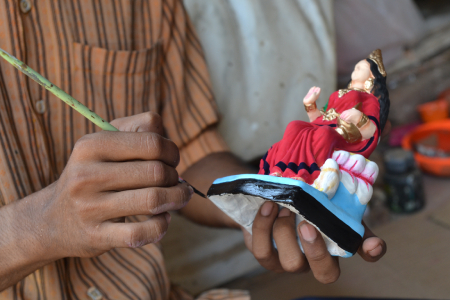
The brilliance of human imagination lies in its transformation of the mundane into magnifique. Being a river basin, West Bengal has a rich abundance of clay, which has been used as a raw material for a wonderful tradition of doll making in Ghurni. From realistic and naturalistic to symbolic, the clay dolls of Ghurni are recognised worldwide. These dolls are unique in their style and in the quality of their finish. The craft persons shape the humble clay into miniature figures. The perfect detailing of form, feature and stance, the meticulous realism of the clothes to the last fold and tuck, and the marvellous expressions make each of the Krishnanagar doll a collector’s item. From dainty human figures to large once, from animals to motifs of religious rituals these art pieces bears the signature of inherent artistic skills as the artists are traditionally practicing the art form since generations without any formal training.
These beautiful, lively clay structures are adorned with vibrant colours. Though the art of doll making has always been an integral part of Bengal’s culture, it gained momentum under the patronage of Maharaja Krishnachandra of Krishnanagar, who was a patron of the art, literature and music. In 1728, he brought families of potters from Dhaka, now in Bangladesh and Natore in West Bengal and settled them in Ghurni.
The clay dolls of Krishnanagar gained immense popularity with the advent of the British who patronised this art and took them to various exhibitions making it a popular art form. The exquisite craftsmanship of these artisans have earned them laurels and accolades from the British royalty like Queen Victoria as well as other important people of the British Raj. The first of the rewarded artist was Sri Ram Paul (1819-1885).



